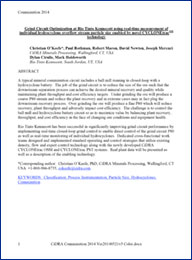2014 Comminution • Grind Circuit Optimization at Rio Tinto Kennecott
Grind Circuit Optimization at Rio Tinto Kennecott Using Real-Time Measurement of Individual Hydrocyclone Overflow Stream Particle Size Enabled by Novel CYCLONEtracSM Technology
A typical mineral comminution circuit includes a ball mill running in closed-loop with a hydrocyclone battery. The job of the grind circuit is to reduce the size of the ore such that the downstream separation process can achieve the desired mineral recovery and quality while maintaining plant throughput and cost efficiency targets. Under grinding the ore will produce a coarse P80 stream and reduce the plant recovery and in extreme cases may in fact plug the downstream recovery process. Over grinding the ore will produce a fine P80 which will reduce recovery, plant throughput and adversely impact cost efficiency. The challenge is to control the ball mill and hydrocyclone battery circuit so as to maximize value by balancing plant recovery, throughput, and cost efficiency in the face of changing ore conditions and equipment health.
Rio Tinto Kennecott has been successful in significantly improving grind circuit performance by implementing real-time closed-loop grind control to enable direct control of the grind circuit P80 as well as real-time monitoring of individual hydrocyclones. Dedicated cross-functional work teams designed and implemented standard operating and control strategies that utilize existing density, flow and expert control technology along with the newly developed CiDRA CYCLONEtrac OSM and CYCLONEtrac PST systems. Real plant data will be presented as well as a description of the enabling technology.

